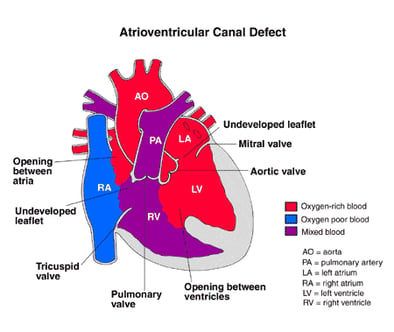
Atrioventricular canal (AVCD or AV canal defect) is a combination of heart defects that are present at birth (congenital). AVCD occurs when the fetal heart doesn’t develop properly during the first two months of pregnancy. The result is several related abnormalities of the heart’s structure, including:
- Atrial septal defect: An opening in the wall between the two upper chambers of the heart (atrial septum).
- Ventricular septal defect: An opening in the wall between the two lower chambers of the heart (ventricular septum).
- Improperly formed mitral and/or tricuspid valves: The valves that separate the upper heart chambers (atria) from the lower heart chambers (ventricles) are not correctly formed. This may mean there is one common valve or two abnormally formed valves between the upper and lower chambers.
Congenital heart disease is present in 50 percent of children born with Down syndrome and roughly 45 percent of these cases have atrioventricular canal defect.




